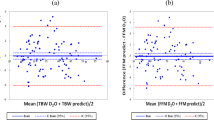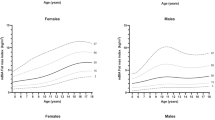Abstract
Background/Objectives:
Few equations for calculating body-fat percentage (BF%) from field methods have been developed in South-Asian children. The objective of this study was to assess agreement between BF% derived from primary reference methods and that from skinfold equations and bio-impedance analysis (BIA) in Indian children.
Subjects/Methods:
We measured BF% in two groups of Indian children. In Pune, 570 rural children aged 6–8 years underwent dual-energy X-ray absorptiometry (DXA) scans. In Mysore 18O in doubly labeled water was administered to 59 urban children aged 7–9 years. We conducted BIA at 50 kHz and anthropometry, including sub-scapular and triceps skinfold thicknesses. We used the published equations of Wickramasinghe, Shaikh, Slaughter and Dezenburg to calculate BF% from anthropometric data and the manufacturer's equation for BIA measurements. We assessed agreement with values derived from DXA and doubly labeled water using Bland–Altman analysis.
Results:
Children were light and thin on average compared with international standards. There was poor agreement between the reference BF% values and those from all equations. Assumptions for Bland–Altman analysis were not met for Wickramasinghe, Shaikh and Slaughter equations. The Dezenberg equations under-predicted BF% for most children (mean difference in Pune −13.4, LOA −22.7, −4.0 and in Mysore −7.9, LOA (−13.7 and −2.2). The mean bias for the BIA equation in Pune was +5.0% and in Mysore +1.95%, and the limits of agreement were wide; −5.0, 15.0 and –7.8, 11.7 respectively.
Conclusions:
Currently available skinfold equations do not accurately predict BF% in Indian children. We recommend development of BIA equations in this population using a four-compartment model.
This is a preview of subscription content, access via your institution
Access options
Subscribe to this journal
Receive 12 print issues and online access
$259.00 per year
only $21.58 per issue
Buy this article
- Purchase on Springer Link
- Instant access to full article PDF
Prices may be subject to local taxes which are calculated during checkout

Similar content being viewed by others
References
Bhardwaj S, Misra A, Khurana L, Gulati S, Shah P, Vikram NK (2008). Childhood obesity in Asian Indians: a burgeoning cause of insulin resistance, diabetes and sub-clinical inflammation. Asia Pac J Clin Nutr 17 (Suppl 1), 172–175.
Bhat DS, Yajnik CS, Sayyad MG, Raut KN, Lubree HG, Rege SS et al. (2005). Body fat measurement in Indian men: comparison of three methods based on a two-compartment model. Int J Obes (Lond) 29, 842–848.
Bland JM, Altman DG (1986). Statistical methods for assessing agreement between two methods of clinical measurement. Lancet 1, 307–310.
Coward A 1990. Calculation of pool sizes and flux rates. The Doubly Labeled Water Method for Measuring Energy Expenditure: A consensus Report by the IDECG Working Group. Technical Recommendations for Use in Humans. International Atomic Energy Agency: Vienna, 48–68.
Deurenberg-Yap M, Chew SK, Deurenberg P (2002). Elevated body fat percentage and cardiovascular risks at low body mass index levels among Singaporean Chinese, Malays and Indians. Obes Rev 3, 209–215.
Deurenberg-Yap M, Schmidt G, Van Staveren WA, Hautvast JG, Deurenberg P (2001). Body fat measurement among Singaporean Chinese, Malays and Indians: a comparative study using a four-compartment' model and different two-compartment models. Br J Nutr 85, 491–498.
Dezenberg CV, Nagy TR, Gower BA, Johnson R, Goran MI (1999). Predicting body composition from anthropometry in pre-adolescent children. Int J Obes Relat Metab Disord 23, 253–259.
Ganpule A, Yajnik CS, Fall CH, Rao S, Fisher DJ, Kanade A . et al. (2006). Bone mass in Indian children--relationships to maternal nutritional status and diet during pregnancy: the Pune Maternal Nutrition Study. J Clin Endocrinol Metab 91, 2994–3001.
Goel K, Gupta N, Misra A, Poddar P, Pandey RM, Vikram NK et al. (2008). Predictive equations for body fat and abdominal fat with DXA and MRI as reference in Asian Indians. Obesity (Silver Spring) 16, 451–456.
Goran MI, Driscoll P, Johnson R, Nagy TR, Hunter G (1996). Cross-calibration of body-composition techniques against dual-energy X-ray absorptiometry in young children. Am J Clin Nutr 63, 299–305.
Huang TT, Watkins MP, Goran MI (2003). Predicting total body fat from anthropometry in Latino children. Obes Res 11, 1192–1199.
Krishnaveni GV, Hill JC, Veena SR, Leary SD, Saperia J, Chachyamma KJ et al. (2005). Truncal adiposity is present at birth and in early childhood in South Indian children. Indian Pediatr 42, 527–538.
Krishnaveni GV, Veena SR, Kuriyan R, Kishore RP, Wills AK, Nalinakshi M et al. (2009). Relationship between physical activity measured using accelerometers and energy expenditure measured using doubly labelled water in Indian children. Eur J Clin Nutr 63, 1313–1319.
Kumar S, Mahabalaraju DK, Anuroopa MS (2007). Prevalence of obesity and its influencing factor among affluent school children of Davangere city. Indian J Community Med 32, 15–17.
Kurpad AV, Borgonha S, Shetty PS (1997). Measurement of total energy expenditure by the doubly labelled water technique in free living Indians in Bangalore city. Indian J Med Res 105, 212–219.
Lobstein T, Baur L, Uauy R (2004). Obesity in children and young people: a crisis in public health. Obes Rev 5 (Suppl 1), 4–104.
Lohman T (1989). Assessment of body composition in children. Pediatr Exerc Sci 1, 19–30.
Lovegrove JA (2007). CVD risk in South Asians: the importance of defining adiposity and influence of dietary polyunsaturated fat. Proc Nutr Soc 66, 286–298.
Misra A, Khurana L (2009). The metabolic syndrome in South Asians: epidemiology, determinants, and prevention. Metab Syndr Relat Disord 7, 497–514.
Misra A, Khurana L, Vikram NK, Goel A, Wasir JS (2007). Metabolic syndrome in children: current issues and South Asian perspective. Nutrition 23, 895–910.
Morrison JA, Guo SS, Specker B, Chumlea WC, Yanovski SZ, Yanovski JA (2001). Assessing the body composition of 6–17-year-old Black and White girls in field studies. Am J Hum Biol 13, 249–254.
Raji A, Seely EW, Arky RA, Simonson DC (2001). Body fat distribution and insulin resistance in healthy Asian Indians and Caucasians. J Clin Endocrinol Metab 86, 5366–5371.
Rush EC, Puniani K, Valencia ME, Davies PS, Plank LD (2003). Estimation of body fatness from body mass index and bioelectrical impedance: comparison of New Zealand European, Maori and Pacific Island children. Eur J Clin Nutr 57, 1394–1401.
Shaikh S, Mahalanabis D (2004). Empirically derived new equations for calculating body fat percentage based on skinfold thickness and midarm circumference in preschool Indian children. Am J Hum Biol 16, 278–288.
Slaughter MH, Lohman TG, Boileau RA, Horswill CA, Stillman RJ, Van L et al. (1988). Skinfold equations for estimation of body fatness in children and youth. Hum Biol 60, 709–723.
Sopher AB, Thornton JC, Wang J, Pierson Jr RN, Heymsfield SB, Horlick M (2004). Measurement of percentage of body fat in 411 children and adolescents: a comparison of dual-energy X-ray absorptiometry with a four-compartment model. Pediatrics 113, 1285–1290.
Taylor RW, Grant AM, Williams SM, Goulding A (2010). Sex differences in regional body fat distribution from pre- to postpuberty. Obesity (Silver Spring) 18, 1410–1416.
Wells JC, Fuller NJ, Dewit O, Fewtrell MS, Elia M, Cole TJ (1999). Four-component model of body composition in children: density and hydration of fat-free mass and comparison with simpler models. Am J Clin Nutr 69, 904–912.
Wells JC, Williams JE, Chomtho S, Darch T, Grijalva-Eternod C, Kennedy K et al. (2010). Pediatric reference data for lean tissue properties: density and hydration from age 5 to 20 y. Am J Clin Nutr 91, 610–618.
Whincup PH, Gilg JA, Papacosta O, Seymour C, Miller GJ, Alberti KG et al. (2002). Early evidence of ethnic differences in cardiovascular risk: cross sectional comparison of British South Asian and white children. BMJ 324, 635.
Wickramasinghe VP, Lamabadusuriya SP, Cleghorn GJ, Davies PS (2008). Assessment of body composition in Sri Lankan children: validation of a skin fold thickness equation. Ceylon Med J 53, 83–88.
Williams JE, Wells JC, Wilson CM, Haroun D, Lucas A, Fewtrell MS (2006). Evaluation of Lunar Prodigy dual-energy X-ray absorptiometry for assessing body composition in healthy persons and patients by comparison with the criterion 4-component model. Am J Clin Nutr 83, 1047–1054.
Wong WW, Hergenroeder AC, Stuff JE, Butte NF, Smith EO, Ellis KJ (2002). Evaluating body fat in girls and female adolescents: advantages and disadvantages of dual-energy X-ray absorptiometry. Am J Clin Nutr 76, 384–389.
World Health Organization. The WHO Child Growth Standards, 2007a: World Health Organization: Geneva. Ref type: data file.
World Health Organization. The world health report 2007—A safer future: global public health security in the 21st century, 2007b: WHO Press: Geneva. Ref type: report.
Yajnik CS, Fall CH, Coyaji KJ, Hirve SS, Rao S, Barker DJ et al. (2003). Neonatal anthropometry: the thin-fat Indian baby. The Pune maternal nutrition study. Int J Obes Relat Metab Disord 27, 173–180.
Acknowledgements
This work was funded by the Medical Research Council and the Wellcome Trust. SHK contributed to data analysis, interpretation of results and drafted the manuscript; GVK, SRV, HGL and DSB carried out newborn and childhood data collection and contributed to manuscript preparation; AKW and AMG carried out the statistical analysis of data, contributed to interpretation of results and manuscript preparation; RK carried out the calculations related to 18O dilution; CHDF designed the study, coordinated the analysis, interpretation and drafting of the paper; CSY designed the study and contributed to interpretation of the results; AK coordinated 18O dilution analysis and related calculations, contributed to interpretation of results and drafting of manuscript.
Author information
Authors and Affiliations
Corresponding author
Ethics declarations
Competing interests
The authors declare no conflict of interest.
Rights and permissions
About this article
Cite this article
Kehoe, S., Krishnaveni, G., Lubree, H. et al. Prediction of body-fat percentage from skinfold and bio-impedance measurements in Indian school children. Eur J Clin Nutr 65, 1263–1270 (2011). https://doi.org/10.1038/ejcn.2011.119
Received:
Revised:
Accepted:
Published:
Issue Date:
DOI: https://doi.org/10.1038/ejcn.2011.119
Keywords
This article is cited by
-
Active children are less adipose and insulin resistant in early adolescence; evidence from the Mysore Parthenon Cohort
BMC Pediatrics (2019)
-
Comparing BMI with skinfolds to estimate age at adiposity rebound and its associations with cardio-metabolic risk markers in adolescence
International Journal of Obesity (2019)
-
A Comparative Study on Fat Pattern between Tribal and Non-tribal Girls of Tripura, North-East India
The Indian Journal of Pediatrics (2019)
-
Body composition during growth in children: limitations and perspectives of bioelectrical impedance analysis
European Journal of Clinical Nutrition (2015)
-
Body fat in Singaporean infants: development of body fat prediction equations in Asian newborns
European Journal of Clinical Nutrition (2013)



